Understanding Wakeboarding: History, Techniques, and Culture
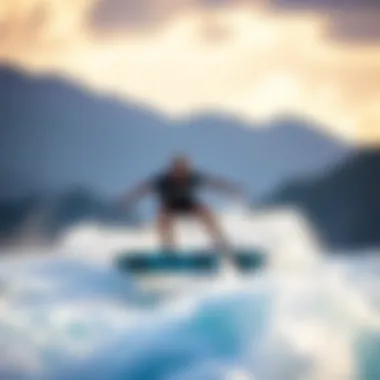
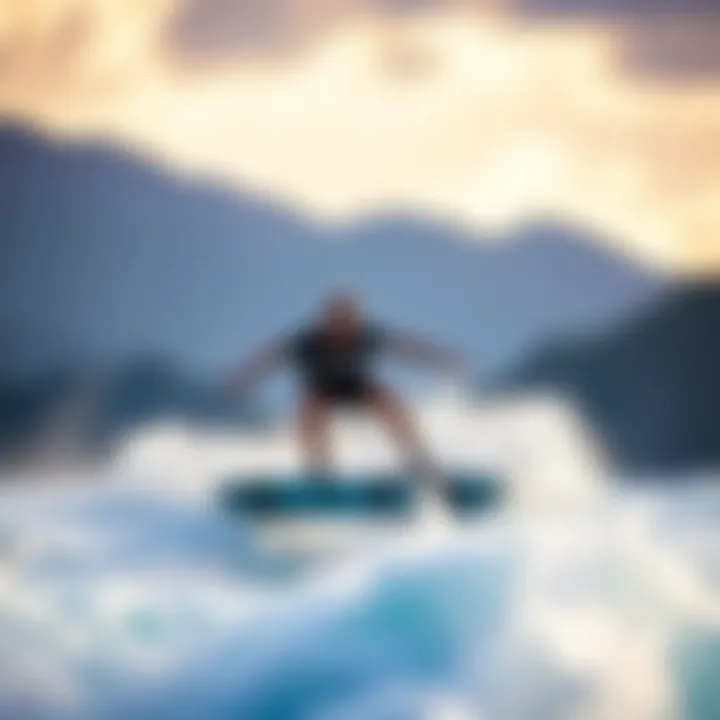
Intro
Wakeboarding, a thrilling blend of surfing, snowboarding, and water skiing, has carved a unique niche in the world of water sports. At its core, this sport combines the adrenaline of high-speed water travel with the artistry of tricks and jumps. For both seasoned riders and newcomers, understanding the elements that make up wakeboarding is essential.
In this article, we will embark on a thorough exploration of wakeboarding, touching upon its origins, techniques, equipment, and the vibrant community that surrounds it. As we delve deeper, you'll see how wakeboarding isn't just a hobby, but also a lifestyle with significant cultural importance.
With the right gear and proper techniques under your belt, you’ll be ready to conquer the waves. Let’s get started on this journey through the captivating world of wakeboarding.
Prelude to Wakeboarding
Wakeboarding has become a significant pastime for many outdoor lovers, combining elements of surfing, snowboarding, and skiing on water. This section endeavors to shine a light on the importance of wakeboarding within the broader realm of water sports, taking a close look at its increasing popularity and multifaceted contribution to the sporting world.
Why Wakeboarding Matters
The sport's dynamic nature not only captivates its participants but also fosters a robust community around it. For those keen on adventure and adrenaline, wakeboarding offers a perfect blend of challenge and excitement. The thrilling experience of being pulled by a boat while gliding over water enhances skills, builds camaraderie, and encourages personal growth. Moreover, wakeboarding embodies the pursuit of enjoyment in nature, reinforcing conservation efforts necessary to maintain water resources.
Definition of Wakeboarding
Wakeboarding is defined as a surface water sport where an individual rides a wakeboard over the water's surface while being towed by a motorboat. The rider is strategically positioned on the board, allowing for a blend of freestyle and edge riding techniques. Unlike traditional surfing, which relies on ocean waves, wakeboarding utilizes the waves created by a boat, giving rise to a distinctly different experience that involves tricks and jumps.
In practical terms, one can think of wakeboarding as a dance on water. The rider maneuvers the board, experiencing the rhythmic pull of the boat, and executing airborne tricks with finesse. The thrill and complexity of the sport often appeal to those seeking more than just a simple ride on the water.
Origins of the Sport
To understand wakeboarding fully, it’s essential to consider its origins, which can be traced back to the 1980s. The sport emerged in California, amidst the backdrop of other water sports gaining traction. Initially, individuals experimented with various boards and wakeskates, blending different styles to craft a new riding experience.
The pivotal moment for wakeboarding came in 1985 when the sport saw its first official competition. This led to the establishment of a wakeboarding culture that quickly attracted enthusiasts. Unlike a mere pastime, it grew into an unmistakable segment of aquatic sports, appealing to thrill-seekers and casual riders alike.
Wakeboarding has evolved significantly since its inception. Several advancements, both in terms of technology and technique, have become commonplace, further enriching the wakeboarding experience for both veterans and novices. The sport continues to spread across the globe, forming communities united by a shared passion for water, thrills, and friendship.
"Wakeboarding is not just a sport, it's a way of life. It brings people together and creates unforgettable memories on water."
In summation, understanding the definition and origins of wakeboarding offers vital insights into its allure and significance, setting the stage for deeper exploration into the various aspects that make this sport unique. Whether one is a newcomer or an enthusiast, the essence and thrill of wakeboarding resonate through its rich history and enthusiastic community.
Technical Aspects of Wakeboarding
Delving into the technical aspects of wakeboarding is crucial for grasping the core of the sport. Understanding these elements not only heightens performance but also ensures safety while riding on the water. This section navigates through the mechanics, types of wakeboards, and the process of selecting the appropriate board to enhance one's experience.
Understanding the Mechanics
At its core, wakeboarding combines the thrill of surfing with the control of snowboarding, relying heavily on mechanics. The sport involves being towed behind a boat, which creates a wake that riders use for jumping and tricks. This wake, created by the boat's speed and hull design, plays a pivotal role in the experience. The balance of weight distribution on the board greatly influences the rider’s ability to carve through the water effectively. For instance, leaning back will lift the nose, while leaning forward engages the fins for sharper turns.
Here are some essential mechanical principles to consider:
- Load and Pop: As the rider edges towards the wake, loading up the line and maintaining tension allows for a powerful pop off the wake.
- Edge Control: Mastering the edge of the board determines how well a rider can cut through the water, impacting speed and maneuverability.
- Tension and Relaxation: Managing the tension on the rope throughout the ride is key; excess tension can lead to mistakes, whereas being too relaxed could cause a loss of control.
Applying these mechanics effectively enhances not only the rider's technique but overall enjoyment of the sport.
Types of Wakeboards
Wakeboards are not one-size-fits-all. Different styles cater to various riding conditions and personal preferences, making understanding types essential. Generally, wakeboards fall into three main categories:
- Continuous Rocker: These boards have a smooth arc from tip to tail, providing a consistent glide and a versatile ride. They’re ideal for those starting out, as they make smooth landings easy.
- Three-Stage Rocker: This design offers a break in the curvature, enabling a more dynamic pop off the wake. Riders looking for explosive aerial tricks often favor this type.
- Hybrid Rocker: Combining elements from both continuous and three-stage rockers, hybrid boards provide a balanced performance suitable for a wide range of styles.
Each of these types cater to distinct aesthetics and performance levels, allowing riders to choose based on their personal riding style or ambitions.
Choosing the Right Wakeboard
Finding the right wakeboard is vital for fostering development and enhancing the overall experience on the water. Several factors should be considered when searching for the perfect match:
- Skill Level: Beginners may opt for a board with a continuous rocker for ease of use, whereas advanced riders might prefer a three-stage rocker for more control and tricks.
- Size: Board size varies based on rider weight and height—generally, lighter riders need smaller boards, while heavier ones will benefit from larger boards, ensuring they float effectively.
- Bindings Compatibility: Choosing the right bindings that complement the board is equally important as they ensure comfort and control while riding. It’s recommended to try out different settings before settling on one.
In summary, selecting a wakeboard goes beyond just looks; it’s about finding the piece that will resonate with the individual’s style and aspirations.
"The right board can make or break your experience on the water, so it pays to do your homework!"
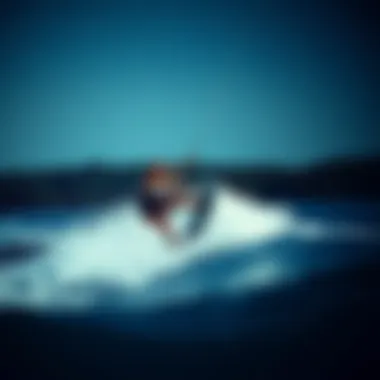
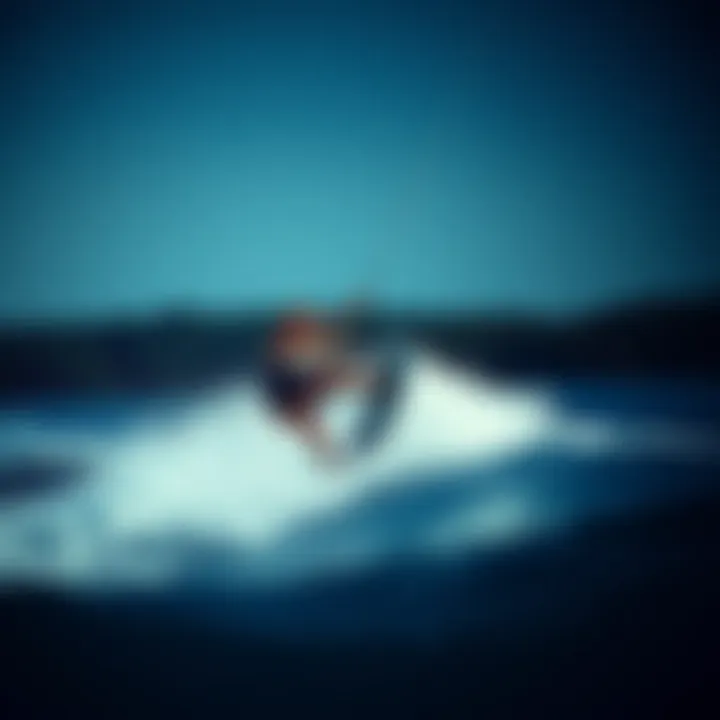
For further information:
Wakeboarding Equipment
Understanding wakeboarding equipment is essential for any enthusiast looking to either begin or better their experience on the water. The right gear can make a significant difference when it comes to performance, comfort, and safety. Investing in quality equipment tailored to individual needs can drastically alter one's capability to enjoy and excel in the sport. This section dives into three critical pieces of equipment: bindings and boots, ropes and handles, and specific details about the boats used in wakeboarding.
Bindings and Boots
Bindings and boots are the keystone elements for any wakeboarder. These features not only enhance performance but also ensure safety while riding. They connect the rider firmly to their board, allowing for better control during maneuvers and tricks.
When choosing bindings, there are a few important considerations:
- Fit: Perfectly fitting bindings should wrap around the foot snugly without pinching. A well-fitted binding will offer optimal support, especially during jumps and landings.
- Flex: The flexibility of boots varies, with some being stiffer, providing better support, while others are softer for mobility. A rider's style and preference determine which flex is suitable.
- Entry System: Bindings come in traditional lace-ups, rear-entry, or Velcro systems. Each has its advantages in ease of use and fit.
Proper bindings are vital, as they can either contribute to or hinder a wakeboarder's performance on the water. Also, when they fit well, they support the rider during the inevitable impact of waves and landings, minimizing the risk of injury.
Ropes and Handles
A wakeboarder’s relationship with their rope and handle is crucial for mastering the sport. Ropes and handles are not mere connectors to the boat but essential tools that help the rider experience the thrill of wakeboarding.
Here’s what to consider:
- Rope Length: Ropes usually range from 60 to 75 feet. A longer rope distance offers more freedom for tricks while a shorter length can help beginners focus on balance.
- Handle Grip: The grips can be made of rubber, foam, or a softer material that offers enhanced comfort. A good handle minimizes the chances of slipping, especially in wet conditions.
- Safety Features: Many handles have knotted sections for easy grip and better control. Some even come equipped with floatation features, which can be highly helpful should the handle slip from a rider’s grasp.
Ultimately, while ropes and handles may seem basic, they play a pivotal role in ensuring performance, ease, and safety when cutting through the water.
Boat Specifics for Wakeboarding
Not all boats are created equal, especially in the wakeboarding arena. The type of boat used can heavily impact the wake produced, which in turn affects how riders maneuver and perform tricks on the water.
When considering a wakeboarding boat, one must pay attention to:
- Hull Design: A vessel with a specific hull design can create larger, more desirable wakes. Flat-bottomed or modified V-hulls tend to produce the best wakes for wakeboarding.
- Ballast System: A good ballast system adds weight to the boat, adjusting the wake size. Some boats come with built-in systems that can be filled or emptied easily, catering to various skill levels.
- Power and Speed: The engine's capacity dictates the vessel’s speed and power. A boat capable of maintaining consistent speed is crucial for wakeboarding.
In summary, understanding the nuances of wakeboarding equipment—from bindings and boots to ropes, handles, and boats—can make or break a session on the water. Investing the time to choose the right gear elevates not only the experience of the sport but also enhances safety, allowing riders to push the limits of their abilities. For further insight into wakeboarding gear and its importance, visit Wakeboarding Community or check information from Wikipedia.
Techniques and Skills
The realm of wakeboarding is not just about standing on a board and gliding across the glassy surface of the water. Instead, it demands a unique repertoire of techniques and skills that can elevate an individual from merely riding to truly mastering the sport. Understanding these nuances not only enhances performance but also enriches the overall experience on the water. By developing specific abilities, wakeboarders can adapt to various conditions and tackle an array of maneuvers, enriching both their skillset and enjoyment of the sport.
Basic Riding Techniques
To kick-start one’s journey in wakeboarding, it’s crucial to grasp the core techniques that underpin the sport. Riding correctly is foundational before one can venture into more advanced stunts. The first step is to learn how to maintain proper posture. Keeping knees bent and shoulders back allows for better balance and control on the water. Once balance is established, the next order of business is learning how to edge the board effectively. Techniques such as creating a smooth transition from heel to toe, and vice versa, can dramatically enhance one’s ride.
Additionally, getting comfortable with the boat’s pull is essential—understanding how to lean back against the line tension will allow for a smoother ride and reduce the likelihood of wiping out. Here are some basic techniques every beginner should practice:
- Setting Up for a Good Start: Positioning oneself correctly in the water to gain maximum traction upon being pulled.
- Using the Handle Efficiently: Holding the handle with both hands close together can offer better stability.
- Practicing Turns: Simple carving from one side to the other not only builds confidence but also enhances control.
Advanced Tricks and Maneuvers
Once the fundamentals are mastered, the world of advanced tricks opens up like a treasure chest. Maneuvers such as jumps, spins, and flips take considerable practice and a keen sense of timing. One seeks to build upon basic riding by incorporating aerial tricks. For example, mastering the method of loading the line can generate necessary tension for a solid pop off the water. Common advanced tricks include:
- The Backflip: A classic move that requires not only strength but also precise timing to initiate the rotation mid-air.
- The 360 Spin: A dynamic trick where the rider makes a full turn while airborne, requiring balance and control throughout.
- Rail Slides: Involving sliding along a surface, this trick is perfect for showcasing style and confidence.
Each of these tricks allows wakeboarders to express their unique style, while continuously challenging their abilities.
Common Mistakes to Avoid
Like any sport, wakeboarding comes with its own set of pitfalls that can trip up even seasoned riders. Recognizing these common mistakes can save a lot of frustration. One frequent misstep is failing to keep a relaxed posture, which can lead to tension and loss of control. Other mistakes include:
- Over-Gripping the Handle: Gripping the handle too tightly can lead to unnecessary fatigue and prevent fluid movement.
- Ignoring Edge Control: Not paying attention to edging can cause abrupt changes in direction, increasing the chances of falling.
- Neglecting to Look Ahead: Instead of focusing solely on the water or the boat, staying aware of the surroundings can prevent collisions or mishaps.
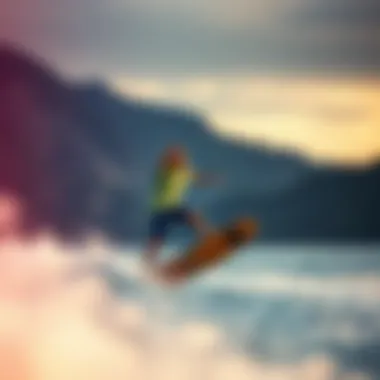

"Remember, practice encompasses every aspect of wakeboarding. Avoiding these common blunders is essential for growth and enjoyment in the sport."
Overall, understanding techniques and skills in wakeboarding allows individuals to become more than just riders. They evolve into confident athletes capable of navigating different waters, executing impressive moves, and enjoying every moment spent out on the water.
For more insights into wakeboarding techniques, you can check out resources like Wakeboarding 101 on Reddit or Wakeboarding Techniques on Wikipedia.
Each ride is an opportunity for improvement, and with perseverance, anyone can find themselves soaring across the water.
Safety Considerations in Wakeboarding
Safety in wakeboarding is paramount for both seasoned riders and newcomers. Given the dynamic nature of the sport, focusing on safety helps prevent accidents and ensures that riders enjoy their sessions. In wakeboarding, risks can come from the environment, equipment failures, or even from the riders themselves. Not prioritizing safety can lead to serious injuries, reinforcing the idea that preparedness and caution are not just wise but essential. When you hit the water, it's not just about skill but also ensuring you’re properly protected, and that your surroundings are safe.
Personal Protective Equipment
Using the right personal protective equipment (PPE) is crucial in minimizing injury while wakeboarding. Here are key pieces of equipment every rider should consider:
- Life Jackets: A properly fitting Coast Guard-approved life jacket is a must. It aids buoyancy and ensures that, in an accidental fall, you remain afloat until help arrives, if needed.
- Helmets: Injuries to the head can be devastating, especially if a rider falls or collides with hard surfaces like the water or obstacles. A good helmet designed specifically for water sports can provide significant protection.
- Impact Vests: These vests absorb impact during falls, offering added cushioning. They’re not buoyant like life jackets but can help protect against injuries especially during higher-speed maneuvers.
Using these protective items might feel cumbersome at first, but your body will thank you later. Safety gear should never be seen as an afterthought; it’s about making sure you can enjoy the sport without having to look over your shoulder for trouble.
"An ounce of prevention is worth a pound of cure." It’s wise to gear up before you get out on the water.
Understanding Water Conditions
Water conditions play a huge role in the safety of wakeboarding. Understanding these can mean the difference between a fun outing and a dangerous situation. Here are some crucial factors to be aware of:
- Water Depth: Always check how deep the water is before you start. Shallow waters can cause serious injuries upon falling and should be avoided.
- Current and Wind: Keep an eye on the wind direction and water current. Wind can make it challenging to control your ride, while strong currents can sweep you dangerously off course.
- Obstacles: Before you venture out, always scout the area for potential obstacles like rocks, logs, or other watercraft. A hidden hazard can turn a thrilling ride into a serious mishap.
- Temperature: The temperature of the water can affect how long you can stay in it. Cold water can lead to hypothermia in a short time; if the water feels too chilly, consider that a warning sign.
When riding in unfamiliar territories, it's always wise to observe conditions and, when in doubt, wait it out. A solid understanding of the environment contributes greatly to a safer and more enjoyable wakeboarding experience.
The Wakeboarding Community
Engagement with a community can turn hobbies into passions, and wakeboarding stands firm as an emblem of togetherness within water sports. The wakeboarding community plays a substantial role in shaping the culture, sharing knowledge, and enhancing skills among all levels of riders. It is defined not just by the sport itself but also by the camaraderie that binds individuals through shared experiences and challenges.
The importance of this community is manifold.
Benefits of Community Involvement
- Skill Development: Riders often benefit tremendously by learning from more experienced wakeboarders. Whether it is mastering a trick or simply improving general riding technique, insights shared in informal settings or structured lessons lead to faster progress.
- Networking Opportunities: Events such as competitions or social gatherings allow both veterans and newcomers to connect, offering pathways to enter sponsorship deals or find riding buddies. In a sport that can sometimes feel isolated on water, building relationships can make all the difference.
- Resource Sharing: Community members are often willing to share gear recommendations, tips on local spots, and even safety advice, which is crucial for both novices and advanced riders aiming to expand their horizons.
"A vibrant community uplifts every single rider, ensuring that no one has to brave the waters alone."
Global Wakeboarding Events
In the world of wakeboarding, events aren’t merely competitions; they are gatherings that draw enthusiasts from all corners of the globe. From the World Wake Association’s Wakeboard World Championships to local grass-roots events, these occasions foster a spirit of competition while showcasing talent. They also provide a forum for enthusiasts to share their unique styles and techniques.
Noteworthy events include:
- The Master’s Tournament: Often considered the crown jewel, this event combines various water sports and attracts elite wakeboarders. The level of talent on display is staggering.
- Wakefest: Celebrated for its lively atmosphere, Wakefest gathers riders and spectators alike, with competitions that span different skill levels, making it a must-attend for any wakeboarding aficionado.
Furthermore, many events emphasize inclusivity, such as adaptive wakeboarding competitions that showcase the determination and skills of riders with disabilities. This inclusivity highlights how wakeboarding brings diverse groups together, forging bonds through shared enthusiasm for the sport.
Prominent Wakeboarders and Influencers
Within the community, several personalities have made significant impacts, not just elevating the sport but also shaping its culture and accessibility.
Athletes such as Shaun Murray, a pioneer in the sport, introduced innovative tricks and inspired a generation. His efforts extend beyond the water; he is known for promoting safety and education in wakeboarding.
On social media platforms, influencers showcase techniques, gear reviews, and experiences, transforming how new riders relate to the sport. For instance, Mike Dowdy often shares insights on his training routines and rehabilitation processes, making wakeboarding relatable and approachable for novices.
In summary, the wakeboarding community is a critical element in the sport, fostering connections, sharing knowledge, and promoting inclusivity. Whether through events, influential personalities, or grassroots organizations, this community keeps the passion and excitement of wakeboarding alive and vibrant, helping it evolve with each passing year.
Environmental Impacts of Wakeboarding

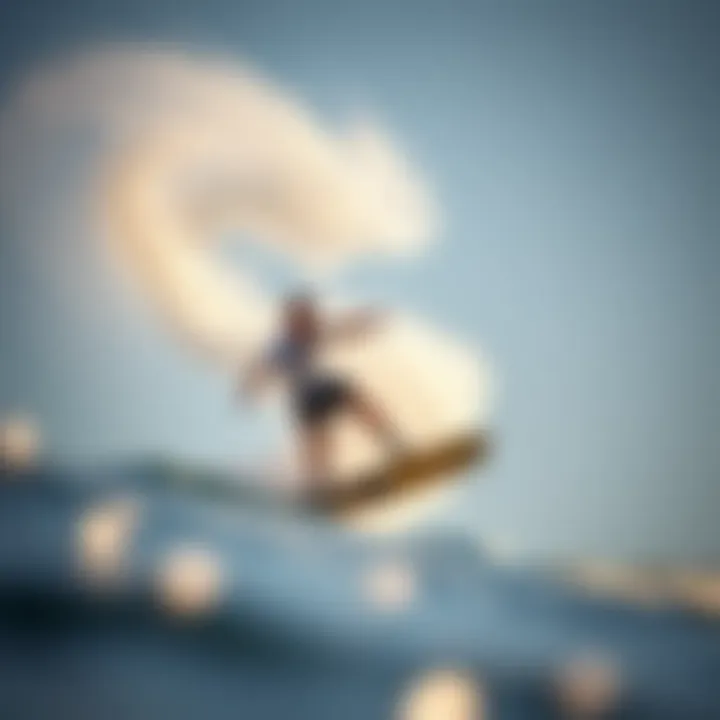
As wakeboarding gains momentum as a popular water sport, it’s crucial to consider its environmental consequences. While the thrill of gliding over water and mastering aerial tricks is exhilarating for enthusiasts, the sport can leave a considerable mark on our waterways and ecosystems. This section sheds light on the potential impacts wakeboarding can have on the environment and emphasizes the importance of integrating sustainable practices into the sport.
Sustainability Practices
Implementing sustainability practices is vital for the future of wakeboarding and the health of our natural resources. Here are some practices that can help minimize the ecological footprint of the sport:
- Choose Eco-friendly Equipment: Manufacturers are increasingly producing wakeboards and accessories using sustainable materials. Opting for boards crafted from recycled or biodegradable materials can significantly reduce waste in oceans and lakes.
- Respect Wildlife: Waters where wakeboarding is popular often host various aquatic life. Maintaining a distance from nests and breeding grounds helps preserve these populations. Observing local wildlife regulations contributes to a healthier ecosystem.
- Educate and Advocate: Raising awareness within the wakeboarding community about environmental preservation is essential. Hosting clean-up events after sessions not only improves local water quality but also fosters a culture of caring for the environment.
Incorporating these practices while enjoying the sport can lead to positive changes, ensuring that wakeboarding remains accessible for generations to come.
Conservation Efforts in Water Sports
The wakeboarding community can also take an active role in broader conservation efforts. Many organizations are dedicated to restoring and maintaining water sports environments. Here’s how the community can connect:
- Collaborate with Local Conservation Groups: Teaming up with local environmental organizations can yield significant results. These partnerships can provide resources and support for initiatives aiming to conserve water quality and habitats.
- Participate in Water Quality Monitoring: Engaging in scientific efforts to track water quality helps identify pollution sources. Regular testing can alert communities to potential threats, facilitating proactive measures before damage occurs.
- Support Local Legislation: Advocating for policies that protect waterways from harm can ensure a sustainable future for wakeboarding. Keeping up with local environmental laws and encouraging participation in public comment periods empowers the community.
"We are not just wakeboarders; we are stewards of our waterways."
Overall, by emphasizing sustainability and engaging in conservation efforts, wakeboarders can champion the balance between enjoying the sport and protecting the delicate ecosystems that support it. These actions will help foster a responsible community that prioritizes environmental health.
For additional information on sustainable practices, consider visiting the following resources:
By evaluating the impact of wakeboarding on the environment and adopting sustainable practices, we can ensure the sport thrives while preserving the beauty and health of our waterways.
Evolution of Wakeboarding Gear
The evolution of wakeboarding gear is crucial to understanding the sport as it fundamentally influences performance, safety, and enjoyment. As with any sport, equipment has adapted over time, pushing the limits of what riders can achieve and enhancing the overall experience on the water. Every new innovation expands not only the capabilities of the wakeboarders but also extends the boundaries of the sport itself.
Historical Development of Boards
The journey of wakeboarding boards traces back to the early days when athletes crafted their own. Initially, these makeshift boards were often nothing more than repurposed surfboards or other watercraft. As demand grew, specialized designs began to emerge. In the late 1980s, pioneers like Obrien and Hyperlite started producing boards specifically for wakeboarding, featuring wider stances and unique rocker shapes that suited the demands of the sport.
The materials used in board construction have evolved dramatically. Beginning with wood, many wakeboards now incorporate advanced materials like fiberglass and carbon fiber, leading to lighter and more durable boards. This change not only enhances performance but also gives riders a feeling of greater control. As boards became increasingly specialized, varied shapes and sizes catered to different riding styles, preferences, and skill levels.
- Traditional boards: Heavy, wooden constructs.
- Modern boards: Lightweight, durable composite materials.
Innovations in Technology
Technological advancements have profoundly changed wakeboarding gear. The introduction of new technologies has brought about significant improvements in both performance and safety. For instance, the advent of adjustable bindings has revolutionized how riders can customize their gear. Now, users can fine-tune the fit of their boots for a more secure ride—an advantage that was nearly unheard of in the past.
Moreover, the integration of smart technology is becoming increasingly commonplace. Some boards now incorporate sensors to monitor performance metrics, helping riders analyze their techniques and make adjustments. This fusion of fitness technology and extreme sports is paving the way for a new generation of athletes, eager to harness data for effectively improving their skills.
To summarize, the ongoing evolution of wakeboarding gear truly shapes the sport. It enhances rider safety, improves performance, and makes wakeboarding more accessible to enthusiasts of all skill levels. As these innovations continue to emerge, one can only imagine how the future of wakeboarding will look, replete with gadgets and technology that we can't yet envision.
"The gear is not just a tool; it's an extension of the rider's abilities and aspirations."
For further insights into the developments in wakeboarding gear and its impact on the sport, check out resources like Wikipedia and Britannica.
Culmination
Concluding an insightful exploration of wakeboarding brings to light several essential elements of this dynamic sport. It is not merely about riding the waves or executing tricks; it embodies a lifestyle that intertwines thrill, camaraderie, and respect for nature.
Future of Wakeboarding
The trajectory of wakeboarding suggests exciting developments on the horizon. As technology continues to evolve, so does the equipment and techniques that enclose this sport. Several key trends indicate what lies ahead:
- Increased Accessibility: With advancements in affordable gear and widespread wake parks, more individuals can engage with wakeboarding without needing a boat. This expansion is likely to recruit a diverse group of enthusiasts.
- Eco-friendly Innovations: As awareness grows regarding environmental impacts, manufacturers are increasingly focused on sustainable materials and practices. Expect to see boards made from recyclable materials and boats designed with greener technologies.
- Incorporating Technology: From smart ropes that measure distance to boards equipped with motion sensors, the blend of tech and wakeboarding will enhance both performance tracking and safety monitoring.
- Competitive Evolution: As the sport garners more attention, competitive platforms are likely to rise, showcasing young talents and new styles. This will cultivate a diverse competitive scene while simultaneously inspiring newcomers.
By keeping an eye on these trends, wakeboarding enthusiasts can not only improve their skills but also actively participate in shaping the sport's future.
Final Thoughts
In closing, the saga of wakeboarding is ever-looming and invigorating. Its ability to adapt to new highs—be it through tech advancements or growing community initiatives—ensures that wakeboarding will thrive. The camaraderie among surfers, the rhythmic splash of water propelled by boots carving through wakes, and the thrill of achieving a once-dreamt trick encapsulate what this sport is truly about.
As you engage with wakeboarding, consider how it fits into your lifestyle and the collective effort from wakeboarders worldwide. Each ride not only contributes to one’s personal growth but also to the vibrant culture that surrounds the sport.
Embrace the journey and invest time in community connections, whether it's learning from seasoned boarders at a local lake or joining forums on platforms like Reddit to discuss techniques and innovations. We stand on the precipice of an exciting phase in wakeboarding—let's dive in together.







